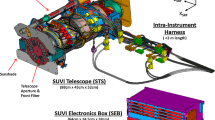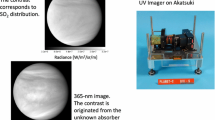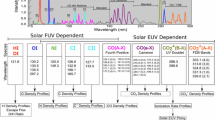Abstract
The aurorae are the result of collisions with the atmosphere of energetic particles that have their origin in the solar wind, and reach the atmosphere after having undergone varying degrees of acceleration and redistribution within the Earth's magnetosphere. The global scale phenomenon represented by the aurorae therefore contains considerable information concerning the solar-terrestrial connection. For example, by correctly measuring specific auroral emissions, and with the aid of comprehensive models of the region, we can infer the total energy flux entering the atmosphere and the average energy of the particles causing these emissions. Furthermore, from these auroral emissions we can determine the ionospheric conductances that are part of the closing of the magnetospheric currents through the ionosphere, and from these we can in turn obtain the electric potentials and convective patterns that are an essential element to our understanding of the global magnetosphere-ionosphere-thermosphere-mesosphere. Simultaneously acquired images of the auroral oval and polar cap not only yield the temporal and spatial morphology from which we can infer activity indices, but in conjunction with simultaneous measurements made on spacecraft at other locations within the magnetosphere, allow us to map the various parts of the oval back to their source regions in the magnetosphere. This paper describes the Ultraviolet Imager for the Global Geospace Sciences portion of the International Solar-Terrestrial Physics program. The instrument operates in the far ultraviolet (FUV) and is capable of imaging the auroral oval regardless of whether it is sunlit or in darkness. The instrument has an 8° circular field of view and is located on a despun platform which permits simultaneous imaging of the entire oval for at least 9 hours of every 18 hour orbit. The three mirror, unobscured aperture, optical system (f/2.9) provides excellent imaging over this full field of view, yielding a per pixel angular resolution of 0.6 milliradians. Its FUV filters have been designed to allow accurate spectral separation of the features of interest, thus allowing quantitative interpretation of the images to provide the parameters mentioned above. The system has been designed to provide ten orders of magnitude blocking against longer wavelength (primarily visible) scattered sunlight, thus allowing the first imaging of key, spectrally resolved, FUV diagnostic features in the fully sunlit midday aurorae. The intensified-CCD detector has a nominal frame rate of 37 s, and the fast optical system has a noise equivalent signal within one frame of ∼ 10R. The instantaneous dynamic range is >1000 and can be positioned within an overall gain range of 104, allowing measurement of both the very weak polar cap emissions and the very bright aurora. The optical surfaces have been designed to be sufficiently smooth to permit this dynamic range to be utilized without the scattering of light from bright features into the weaker features. Finally, the data product can only be as good as the degree to which the instrument performance is characterized and calibrated. In the VUV, calibration of an an imager intended for quantitative studies is a task requiring some pioneering methods, but it is now possible to calibrate such an instrument over its focal plane to an accuracy of ±10%. In summary, very recent advances in optical, filter and detector technology have been exploited to produce an auroral imager to meet the ISTP objectives.
Similar content being viewed by others
References
Ajello, J. M. and Shemansky, D. E.: 1985, ‘A Reexamination of Important N2 Cross Sections by Electron Impact with Application to the Dayglow: The Lyman-Birge-Hopfield Band System and NI (119.99 nm)’,J. Geophys. Res. 90, 9845.
Ajello, J. M., Shemansky, D. E., Franklin, B., Watkins, J., Srivastava, S., James, G. K., Simms, W. T., Hord, C. W., Pryor, W., McClintock, W., Argabright, V., and Hall, D.: 1987, ‘A Simple Ultraviolet Calibration Source with Reference Spectra and Application to the Galileo Orbiter Ultraviolet Spectrometer’,Appl. Opt. 27, 890.
Akasofu, S.-I.: 1981, in S.-I. Akasofu and J. R. Kan (eds.),Physics of Auroral Arc Formation, Auroral Arcs and Auroral Potential Structure, AGU Geophysical, Monograph, Washington D.C.
Allen, C. W., 1973,Astrophysical Quantities, Athlone Press, University of London.
Anger, C. D., Fancott, T., McNally, J., and Kerr, H. S.: 1973, ‘ISIS-II Scanning Auroral Photometer’,Appl. Opt. 12, 1753.
Anger, C. D., Babey, S. K., Broadfoot, A. L., Brown, R. G., Cogger, L. L., Gattinger, R., Haslett, J. W., King, R. A., McEwen, D. J., Murphree, J. S., Richardson, E. H., Sandel, B. R., Smith, K., and Vallance Jones, A.: 1987, ‘An Ultraviolet Auroral Imager for the Viking Spacecraft’,Geophys. Res. Letters 14, 387.
Barth, C. A.: 1966, in A. Green (ed.),The Middle Ultraviolet: Its Science and Technology, The Ultraviolet Spectroscopy of Planets, John Wiley and Sons, New York.
Cook, I. G.: 1987, in C. Londono and R. I. Fischer (eds.), ‘Recent Trends in Optical Systems Design: Computer Lens Design Workshop, Wide Field of View Three-Mirror Anastigmatic (TMA) Employing Spherical Secondary and Tertiary Mirrors’,Proc. SPIE,766, 158.
Fennelly, J. A., Torr, D. G., Richards, P. G., and Torr, M. R.: 1994, ‘Simultaneous Retrieval of the Solar EUV Flux and Neutral Thermospheric O, O2, N2 and Temperature from Twilight Airglow’,J. Geophys. Res. 99, 6483.
Frank, L. A., Craven, J. D., Ackerson, K. L., English, M. R., Eather, R. H., and Carovillano, R. L.: 1981, ‘Global Auroral Imaging Instrumentation for the Dynamics Explorer Mission’,Space Sci. Instr. 5, 369.
Germany, G. A., Torr, M. R., Richards, P. G. and Torr, D. G.: 1990, ‘Dependence of ModeledOi 1356 and N2 LBH Auroral Emissions on the Neutral Atmosphere’,J. Geophys. Res. 95, 7725.
Germany, G. A., Torr, M. R., Torr, D. G., and Richards, P. G.: 1994a, ‘The Use of FUV Auroral Emissions as Diagnostic Indicators’,J. Geophys. Res. 99, 383.
Germany, G. A., Torr, D. G., Torr, M. R., and Richards, P. G.: 1994b, ‘The Determination of Ionospheric Conductances from FUV Auroral Images’,J. Geophys. Res. 99, 383.
Heroux, L. and Swirbalus, R. A.: 1976,J. Geophys. Res. 81, 436.
Hirao, K. and Itoh, T.: 1978, ‘Scientific Satellite Kyokko (EXOS-A)’,Solar Terrest. Env. Res. in Japan 2, 148.
Johnson, R. B.: 1988, ‘Wide Field of View Three-Mirror Telescopes Having a Common Optical Axis’,Opt. Eng. 27, 1046.
Kamide, Y. and Richmond, A. D.: 1982, ‘Ionospheric Conductivity Dependence of Electric Fields and Currents Estimated from Ground Magnetic Observations’,J. Geophys. Res. 87, 8331.
Kaneda, E., Takgi, M., and Niwa, N.; 1977, ‘Vacuum Ultraviolet Television Camera’,Proc. 12th Int. Symp. Space Tech. Sci., Agne, Tokyo, pp. 233–238.
Keffer, C. E., Torr, M. R., Zukic, M., Spann, J. F., Torr, D. G., and Kim, J.: 1993, ‘Radiation Damage Effects in Far Ultraviolet Filters and Substrates’, SPIE Vol. 2018,Passive Materials for Optical Elements II, p. 92.
Korsch, D.: 1975, ‘Three Mirror Space Telescope’,Opt. Eng. 14, 533.
Korsch, D.: 1977, ‘Ariastigmatic Three-Mirror Telescope’,Appl. Opt. 16, 1074.
Korsch, D.: 1980, ‘Design and Optimization Technique for Three-Mirror Telescopes’,Appl. Opt. 19, 3640.
Meng, C. I. and Huffman, R. E.: 1984, ‘Ultraviolet Imaging from Space of the Aurora Under Full Sunlight’,Geophys. Res. Letters 11, 315.
Oguti, T., Kaneda, E., Ejiri, M., Sasaki, S., Kadokura, A., Yamamoto, T., Hayashi, K., Fujii, R., and Makita, K.: 1990, ‘Studies of Aurora Dynamics by Aurora-TV on the Akebono (EXOS-D) Satellite’,J. Geomag. Geoelectr. 42, 555.
Richards, P. G.: 1991, ‘An Improved Algorithm for Determining Neutral Winds from the Height of the F2 Peak Electron Density’,J. Geophys. Res. 96, 17839.
Richards, P. G., Fennelly, J., and Torr, D. G.: 1994, ‘EUVAC: Solar EUV Flux Model for Aeronomic Calculations’,J. Geophys. Res. 99, 8981.
Rogers, E. H., Nelson, D. F., and Savage, R. C.: 1974, ‘Auroral Photography from a Satellite’,Science 183, 951.
Torr, M. R.: 1985, Persistence of phosphor glow in microchannel plate image intensifiers,Appl. Opt.,24, 793.
Torr, M. R. and Devlin, J.: 1982, ‘Intensified Charge Coupled Device for Use as a Spaceborne Spectrographic Image Plane Detector System’,Appl. Opt. 21, 3091.
Torr, M. R. and Torr, D. G.: 1995, ‘A Compact Imaging Spectrometer for Broadband Spectral Simultaneity’,Appl. Opt. (in press).
Torr, M. R. and Vitz, R. C.: 1982, ‘An Extreme Ultraviolet Imaging Spectrometer for Thermospheric Emissions’,Appl. Opt. 21, 3080.
Torr, D. G. and Zukic, M.: 1995, ‘Absolute Calibration of a Focal Plane Detector System in the FUV’,Appl. Opt. (submitted).
Torr, D. G., Torr, M. R., Zukic, M., Spann, J., and Johnson, R. B.: 1993, ‘Ultraviolet Imager for the International Solar Terrestrial Physics Mission,Optical Engineering 32, 3060.
Torr, M. R., Torr, D. G., and Hinteregger, H. E.: 1980, ‘Solar Flux Variability in the Schumann-Runge Continuum as a Function of Solar Cycle 21’,J. Geophys. Res. 85, 6063.
Torr, M. R., Torr, D. G., Baum, R., and Spielmaker, R.: 1986, ‘Intensified-CCD Focal Plane Detector for Space Applications: A Second Generation’,Appl. Opt. 25, 2768.
Torr, M. R., Torr, D. G., Chang, T., Richards, P., Swift, W., and Li, N., 1994, Thermospheric and mesospheric nitric oxide from the ATLAS-1 and Spacelab 1 missions,J. Geophys. Res. (submitted), June.
Torr, M. R., Torr, D. G., Chang, T., Richards, P. and Germany, G.: 1994c, ‘The N2 Lyman-Birge-Hopfield Dayglow from ATLAS-1’,J. Geophys. Res. 99, 21397.
Zukic, M., Torr, D. G., Spann, J. F., and Torr, M. R.: 1990a, ‘VUV Thin Films, Part I: Optical Constants of BaF2, CaF2, LaF2, MgF2, Al2O3, HfO2, and SiO2,Appl. Opt. 29, 4284.
Zukic, M., Torr, D. G., Spann, J. F., and Torr, M. R.: 1990b, ‘VUV Thin Films, Part II: Vacuum Ultraviolet-Dielectric Narrowband Filters’,Appl. Opt. 29, 4293.
Zukic, M., Torr, D. G., Kim, J., Spann, J., and Torr, M. R.: 1993, ‘Filters for the International Solar Terrestrial Physics Mission Far-Ultraviolet Imager’,Optical Engineering 32, 3069.
Author information
Authors and Affiliations
Rights and permissions
About this article
Cite this article
Torr, M.R., Torr, D.G., Zukic, M. et al. A far ultraviolet imager for the International Solar-Terrestrial Physics Mission. Space Sci Rev 71, 329–383 (1995). https://doi.org/10.1007/BF00751335
Received:
Issue Date:
DOI: https://doi.org/10.1007/BF00751335




